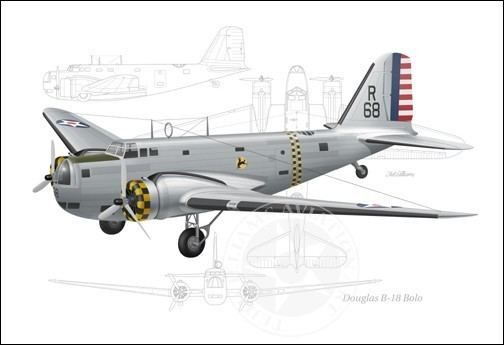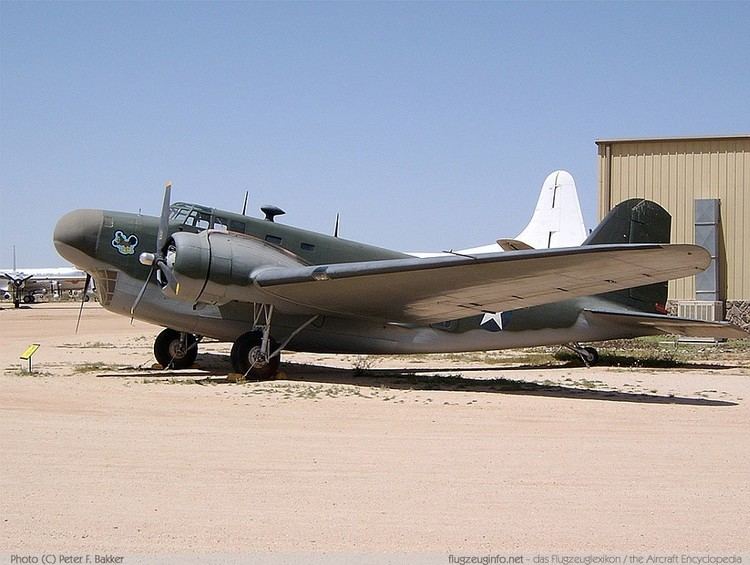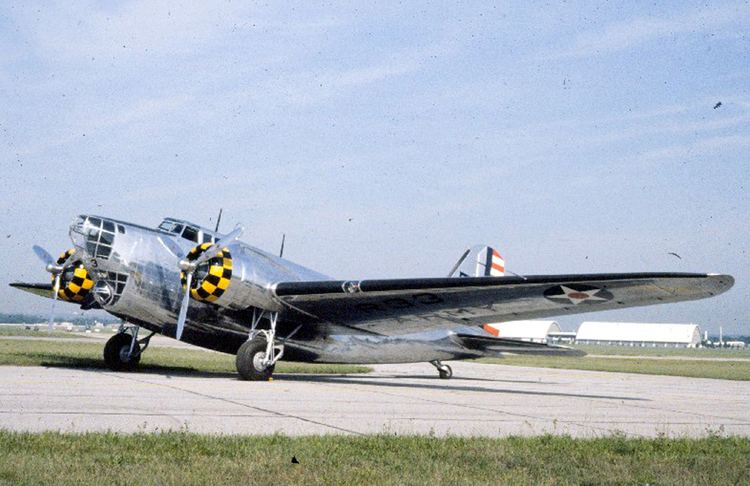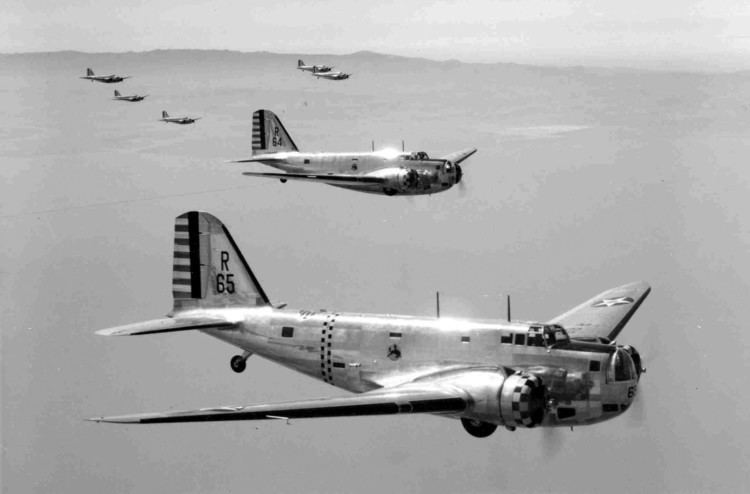Top speed 348 km/h Wingspan 27 m Unit cost 58,500–58,500 USD (1935) | Range 1,931 km Length 18 m First flight April 1935 | |
 | ||
Douglas b 18 bolo flying over at lassen peak
The Douglas B-18 Bolo is an American medium bomber which served with the United States Army Air Corps and the Royal Canadian Air Force (as the Digby) during the late 1930s and early 1940s. The Bolo was built by the Douglas Aircraft Company, based on its DC-2, and was developed to replace the Martin B-10.
Contents
- Douglas b 18 bolo flying over at lassen peak
- Douglas b 18 bolo pictures
- Design and development
- Operational history
- World War II
- Variants
- Operators
- Aircraft on display
- Specifications B 18A
- References

By 1940, it was considered to be underpowered, to have inadequate defensive armament and to carry too small a bomb load. Many were destroyed during the attacks on Pearl Harbor and the Philippines in December 1941.

In 1942, the B-18 survivors were relegated to antisubmarine or transport duty. A B-18 was one of the first American aircraft to sink a German U-boat, U-654 on 22 August 1942 in the Caribbean.

Douglas b 18 bolo pictures
Design and development

In 1934, the United States Army Air Corps put out a request for a bomber with double the bomb load and range of the Martin B-10, which was just entering service as the Army's standard bomber. In the evaluation at Wright Field the following year, Douglas showed its DB-1. It competed with the Boeing Model 299 (later the Boeing B-17 Flying Fortress) and Martin Model 146.

While the Boeing design was clearly superior, the crash of the B-17 prototype (caused by taking off with the controls still locked) removed it from consideration. During the depths of the Great Depression, the lower price of the DB-1 ($58,500 vs. $99,620 for the Model 299) also counted in its favor. The Douglas design was ordered into immediate production in January 1936 as the B-18.

The DB-1 design was essentially that of the DC-2, with several modifications. The wingspan was 4.5 ft (1.4 m) greater. The fuselage was deeper, to better accommodate bombs and the six-member crew; the wings were fixed in the middle of the cross-section rather than to the bottom due to the deeper fuselage. Added armament included nose, dorsal, and ventral gun turrets.
Preston Tucker's firm received a contract to supply a remote controlled gun turret for the aircraft.
Operational history
The initial contract called for 133 B-18s (including DB-1), using Wright R-1820 radial engines. The last B-18 of the run, designated DB-2 by the company, had a power-operated nose turret. This design did not become standard. Additional contracts in 1937 (177 aircraft) and 1938 (40 aircraft) were for the B-18A, which had the bombardier's position further forward over the nose-gunner's station. The B-18A also used more powerful engines.
Deliveries of B-18s to Army units began in the first half of 1937, with the first examples being test and evaluation aircraft being turned over to the Materiel Division at Wright Field, Ohio, the Technical Training Command at Chanute Field, Illinois, the Aberdeen Proving Ground, Maryland, and Lowry Field, Colorado. Deliveries to operational groups began in late 1937, the first being the 7th Bombardment Group at Hamilton Field, California.
Production B-18s, with full military equipment fitted, had a maximum speed of 217 mph, cruising speed of 167 mph, and combat range of 850 miles. By 1940, most USAAC bomber squadrons were equipped with B-18s or B-18As.
However, the deficiencies in the B-18/B-18A bomber were becoming readily apparent to almost everyone. In range, in speed, in bomb load, and particularly in defensive armor and armament, the design came up short, and the Air Corps conceded that the aircraft was obsolete and totally unsuited in the long-range bombing role for which it had originally been acquired. To send crews out in such a plane against a well-armed, determined foe would have been nothing short of suicidal.
However, in spite of the known shortcomings of the B-18/B-18A, the Douglas aircraft was the most numerous American bomber type deployed outside the continental United States at the time of the attack on Pearl Harbor. It was hoped that the B-18 could play a stopgap role until more suitable aircraft such as the Boeing B-17 Flying Fortress and Consolidated B-24 Liberator became available in quantity.
World War II
When war came to the Pacific, most of the B-18/B-18A aircraft based overseas in the Philippines and in Hawaii were destroyed on the ground in the initial Japanese onslaught. The few Bolos that remained played no significant role in subsequent operations.
The Bolos remaining in the continental US and in the Caribbean were then deployed in a defensive role in anticipation of attacks on the US mainland. These attacks never materialized. B-17s supplanted B-18s in first-line service in 1942. Following this, 122 B-18As were modified for anti-submarine warfare. The bombardier was replaced by a search radar with a large radome. Magnetic anomaly detection (MAD) equipment was sometimes housed in a tail boom. These aircraft, designated B-18B, were used in the Caribbean on anti-submarine patrol. On 2 October 1942, a B-18A, piloted by Captain Howard Burhanna Jr. of the 99th Bomb Squadron, depth charged and sank the German submarine U-512 north of Cayenne, French Guiana.
Two aircraft were transferred to Força Aérea Brasileira in 1942 and used with a provisional conversion training unit set up under the provisions of Lend-Lease. They were later used for anti-submarine patrols. They were struck off charge at the end of the war. In 1940 the Royal Canadian Air Force acquired 20 B-18As (as the Douglas Digby Mark I), and also used them for patrol duties, being immediately issued to 10 Squadron to replace the squadron's Westland Wapitis.
Bolos and Digbys sank an additional two submarines during the course of the war. RCAF Eastern Air Command (EAC) Digbys carried out 11 attacks on U-boats. U-520 was confirmed sunk by Flying Officer F. Raymes' crew of No. 10 (BR) Squadron, on 30 October 1942. east of Newfoundland. However, the antisubmarine role was relatively short-lived, and the Bolos were superseded in this role in 1943 by Consolidated B-24 Liberators which had a much heavier payload and a substantially longer range which finally closed the mid-Atlantic gap.
Surviving USAAF B-18s ended their useful lives in training and transport roles within the continental United States, and saw no further combat action. Two B-18As were modified as unarmed cargo transports under the designation C-58. At the end of the war, those bombers that were left were sold as surplus on the commercial market. Some postwar B-18s of various models were operated as cargo or crop-spraying aircraft by commercial operators.
Variants
Operators
**Note: Most aircraft destroyed 7–8 December 1941 at outbreak of World War II
Aircraft on display
Only six B-18s still exist, five of them preserved or under restoration in museums in the United States:
Specifications (B-18A)
Data from McDonnell Douglas Aircraft since 1920
General characteristics
Performance
Armament
